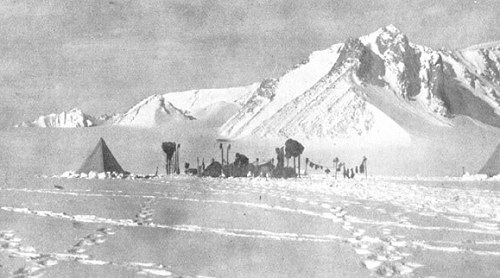
| Glasgow Digital Library | Voyage of the Scotia | BRUCE | PEOPLE | SHIP | ANTARCTIC | INDEX |
|---|
Robert Scott wanted only Royal Navy crew, but in the end there were two Merchant Navy officers and a few Merchant Navy crew. Only Armitage (second in command and veteran of the Jackson-Harmsworth expedition) was to stay on board Discovery for the whole trip.
Scott and Shackleton were not particularly interested in ice and snow and were appallingly ignorant of skis, sledges and furs. There was a marked comparison with William Speirs Bruce and the efficient, well-organised Amundsen.
Discovery was to cost £45,000 - much more expensive than Bruce's Scotia. The expedition only carried sledge dogs after the insistence of the polar explorer Fridjtof Nansen. Twenty-three sledge dogs were taken.
Discovery left New Zealand dangerously overloaded, but was lucky with the weather on the voyage south. Scott had no knowledge of ice navigation and on two occasions Armitage and Royds helped to get Discovery out of trouble.
The expedition arrived in McMurdo Sound unprepared for the conditions. During the first winter vital preparations for the spring in preparing sledges were ignored. Shackleton was in charge of the dogs but no training took place over the winter. They never learned to ski properly. When Peary went north he trained with his dog team for two years.
Advice was not taken on the importance of fresh meat, and scurvy became a problem until Scott and the cook were persuaded that fresh meat - mainly seal meat - was essential. Tinned food was not a good source of vitamin C. The Swedish explorer Nordenskjold had a very successful sledge journey in the south and covered 82km (51 miles) in three days. Scott, Shackleton and Wilson took 12 days for a similar journey with dogs.
Food supplies proved inadequate for Shackleton's first trip south with Scott and they were on half rations when they turned back to base. All three were suffering from scurvy.
The expedition reached base at Hut Point with only two dogs and three very ill explorers. Scott insisted on Shackleton returning home with most of the other Merchant Navy crew. (Armitage was kept on.)
Shackleton returned home first to a hero's welcome - which was to annoy Scott.
The public view of the Antarctic at the time
The epic survival of Nordenskjold's ship Antarctic received full-page coverage in the Times, while the first aircraft flight by the Wright brothers' plane at Kittyhawk was not mentioned.
Shackleton was to become secretary of the Royal Scottish Geographical Society. One of his tasks was to welcome the Scottish polar explorer William Speirs Bruce back to Scotland. He became involved in various speculative enterprises - none of them very profitable. He longed to return to the Antarctic and began raising funds.

| Glasgow Digital Library | Voyage of the Scotia | BRUCE | PEOPLE | SHIP | ANTARCTIC | INDEX |
|---|